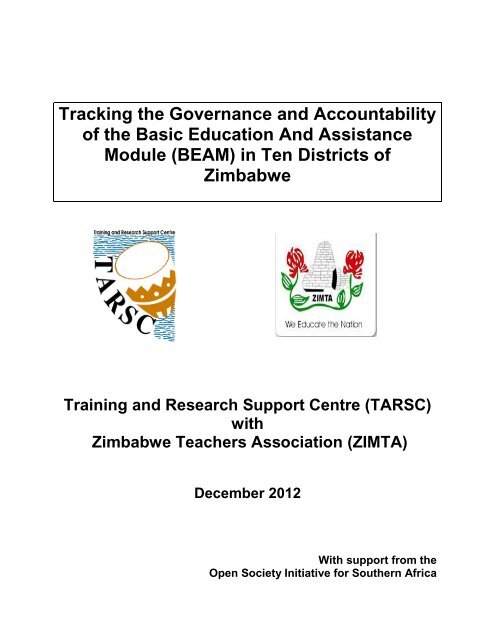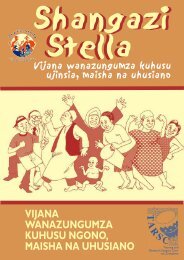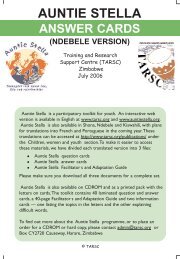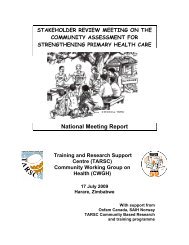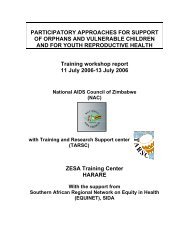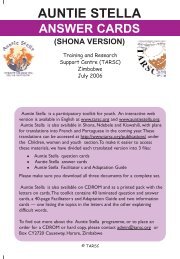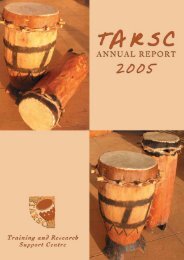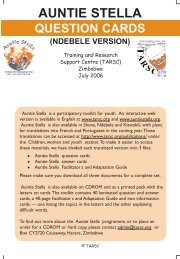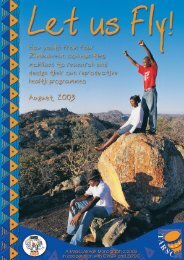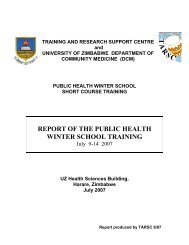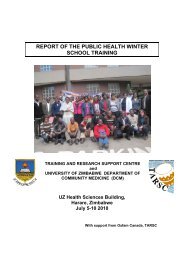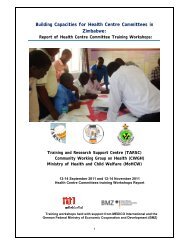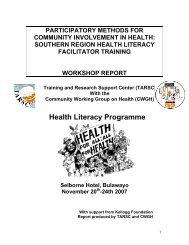BEAM rep final.pdf - Training and Research Support Centre
BEAM rep final.pdf - Training and Research Support Centre
BEAM rep final.pdf - Training and Research Support Centre
You also want an ePaper? Increase the reach of your titles
YUMPU automatically turns print PDFs into web optimized ePapers that Google loves.
Tracking the Governance <strong>and</strong> Accountability<br />
of the Basic Education And Assistance<br />
Module (<strong>BEAM</strong>) in Ten Districts of<br />
Zimbabwe<br />
<strong>Training</strong> <strong>and</strong> <strong>Research</strong> <strong>Support</strong> <strong>Centre</strong> (TARSC)<br />
with<br />
Zimbabwe Teachers Association (ZIMTA)<br />
December 2012<br />
With support from the<br />
Open Society Initiative for Southern Africa
Table of Contents<br />
Executive Summary ................................................................................................................................... 2<br />
1. Background <strong>and</strong> rationale ................................................................................................................. 5<br />
1.1 The budget Process <strong>and</strong> Actors ................................................................................................ 6<br />
1.2 <strong>BEAM</strong> Programme ...................................................................................................................... 6<br />
1.3 Institutional arrangement of the <strong>BEAM</strong> .................................................................................... 9<br />
1.4 Stakeholder Mapping for <strong>BEAM</strong> .............................................................................................. 10<br />
1.5 The Pilot Survey ........................................................................................................................ 11<br />
2. Aims of the Assessment .................................................................................................................. 12<br />
3. Methods ............................................................................................................................................. 12<br />
4. Findings ............................................................................................................................................. 14<br />
3.1 Governance of <strong>BEAM</strong> Funds ................................................................................................... 15<br />
3.2 Accountability for <strong>BEAM</strong> Funds ............................................................................................... 16<br />
3.3 Beneficiaries Views of <strong>BEAM</strong> Programme ............................................................................ 17<br />
3.4 Selection Committee, Accountability <strong>and</strong> Governance Issues ........................................... 18<br />
3.5 Summary of Key informant views on <strong>BEAM</strong> ......................................................................... 19<br />
5. Discussion ......................................................................................................................................... 20<br />
6. Recommendations ........................................................................................................................... 21<br />
7. References ........................................................................................................................................ 23<br />
7.1 Abbreviations .................................................................................................................................. 23<br />
Cite this publication as: <strong>Training</strong> <strong>and</strong> <strong>Research</strong> <strong>Support</strong> <strong>Centre</strong> (TARSC), Zimbabwe Teachers<br />
Association ZIMTA (2012) Tracking the Governance <strong>and</strong> Accountability of the Basic Education<br />
Assistance Module (<strong>BEAM</strong>) in ten districts of Zimbabwe TARSC Harare.<br />
Acknowledgements:<br />
We acknowledge with thanks the Ministry of Labour <strong>and</strong> Social Welfare for the input to the study<br />
questions, the Community Monitoring Coordinating Committee (CMCC) for the input to the protocol <strong>and</strong><br />
The Ministry of Education Sport <strong>and</strong> Culture for permission to interview School Authorities.<br />
1
Executive Summary<br />
The Basic Education Assistance Module (<strong>BEAM</strong>) is one of the important pro-poor funds that are<br />
meant for the marginalised <strong>and</strong> vulnerable communities in Zimbabwe. <strong>BEAM</strong> is a programme<br />
that provides school fees, examination fees, levies <strong>and</strong> building assistance. It was introduced by<br />
the Government of Zimbabwe in 2001. It targets the vulnerable children who are unable to pay<br />
school fees or those who fail to go to school as a result of non-availability of money. According<br />
to a 2012 <strong>BEAM</strong> evaluation <strong>rep</strong>ort, of the estimated 3.6 million children of school going age<br />
(primary <strong>and</strong> secondary) in Zimbabwe, approximately 1 million of them are in need of financial<br />
assistance. Out of the 2.8 million primary school going children an estimated 28% of them are in<br />
need of fund assistance. However, only 16% are received the funds in the previous year. For<br />
secondary schools pupils the <strong>rep</strong>ort notes that about 24% children needed assistance with only<br />
17% receiving the assistance.<br />
Apart from inadequate funds to pay for those in need, there are a number of fund management,<br />
accounting <strong>and</strong> governance issues that have affected the programme since its inception. Prior<br />
to this work the <strong>Training</strong> <strong>and</strong> <strong>Research</strong> <strong>Support</strong> <strong>Centre</strong> (TARSC) carried out a pilot survey on<br />
<strong>BEAM</strong> <strong>and</strong> identified a number of issues affecting its operations that require closer monitoring<br />
<strong>and</strong> evaluation of the schools on the use of funds by their parent ministry, the funding ministry<br />
(Ministry of Labour <strong>and</strong> Social Welfare) <strong>and</strong> other funding agencies. The pilot survey noted that<br />
selection of beneficiaries was cumbersome <strong>and</strong> prone to manipulation. The administration of the<br />
programme was perceived as not transparent in some schools.<br />
To assess some of these operational challenges <strong>and</strong> offer some suggestions to improve the<br />
administration of <strong>BEAM</strong>, TARSC in association with Zimbabwe Teachers Association (ZIMTA)<br />
carried out a survey to assess the general underst<strong>and</strong>ing of the <strong>BEAM</strong> programme by those<br />
who are executing it <strong>and</strong> benefiting from it at the local district level.<br />
A cross sectional survey was implemented in 10 districts selected on the basis of vulnerability<br />
from nine out of the ten provinces of Zimbabwe. The survey obtained information from 200 key<br />
informants (school Heads, bursars <strong>and</strong> accounts clerks), <strong>and</strong> 189 beneficiaries through<br />
structured interviews. It assessed the availability <strong>and</strong> use of <strong>BEAM</strong> guidelines in schools, the<br />
criteria for selection of beneficiaries <strong>and</strong> the underst<strong>and</strong>ing of the selection guidelines by the<br />
school authorities <strong>and</strong> selection committees, the accounting <strong>and</strong> auditing of the <strong>BEAM</strong> funds<br />
<strong>and</strong> the organs that carry out the auditing, the frequency of those audits <strong>and</strong> the disbursements<br />
<strong>and</strong> absorption of funds by the Ministry of Finance <strong>and</strong> schools respectively. ZIMTA provided all<br />
the research assistants that were used in the survey drawn from all the nine participating<br />
districts of Zimbabwe. TARSC provided the technical inputs, training, analysis <strong>and</strong> <strong>rep</strong>orting.<br />
The Open Society Initiative for Southern Africa (OSISA) provided the funding for the survey..<br />
The research assistants from ZIMTA were trained for a day on how to administer the key<br />
informant <strong>and</strong> beneficiary questionnaires.<br />
Results from the survey showed that <strong>BEAM</strong> support was valued by beneficiaries <strong>and</strong> schools.<br />
The funds allocated to the <strong>BEAM</strong> programme were however found to be inadequate relative to<br />
need. Of the 15 243 potential beneficiaries in the participating schools’ registers, only 8533<br />
(56%) were receiving <strong>BEAM</strong> assistance as a result of inadequate funds.<br />
Faced with a large number of potential beneficiaries versus limited resources, there were issues<br />
of non coverage of people in need <strong>and</strong> issues raised on funds were allocated to those who did<br />
receive. About a third (38.1%) of community elders interviewed observed that schools did not<br />
display a list of the <strong>BEAM</strong> beneficiaries on the public notice board. The public display of names<br />
2
as seen to be a way the community could verify those who had benefitted to ensure<br />
transparency <strong>and</strong> fairness in the selection of beneficiaries.<br />
The auditing of the <strong>BEAM</strong> funds remained a challenge in most of the schools surveyed, with the<br />
ministry having given up that role to the school development committees <strong>and</strong> other independent<br />
monitors. This made it difficult for the MoLSW to properly monitor the use of these funds. It is<br />
important to note that 93% of the schools surveyed included <strong>BEAM</strong> funds with other funds in the<br />
school’s general account, posing challenges when accounting specfically for the <strong>BEAM</strong> funds.<br />
Most of the schools surveyed (65%) <strong>rep</strong>orted not having any or not being aware of manuals that<br />
gave directions on how the <strong>BEAM</strong> funds could be accounted for, including the rules for the fund<br />
management.<br />
The <strong>BEAM</strong> programme experienced late disbursement of funds that compounded the financial<br />
problems of schools that had greater numbers of their pupils on the benefit. As a result of the<br />
late disbursement of these funds; there were cases of schools remaining with unused funds at<br />
the end of the year, either because the guardians (72.4% of guardians in this survey) of the<br />
beneficiaries would have used their own money to pay for fees <strong>and</strong> levies, or the beneficiaries<br />
would have dropped out of school completely. In cases where guardians would have used their<br />
own funds, there were no cases of schools reimbursing the guardians their money, even though<br />
this may have been obtained through loans or impoverishing sales of assets.<br />
In order to address some of the operational problems such as accountability <strong>and</strong> good<br />
governance of the of the <strong>BEAM</strong> programme at the local level, key informants proposed that;<br />
On Governance <strong>and</strong> Financial Accountability<br />
It needs to be made clear who audits the <strong>BEAM</strong> funds. Some schools <strong>rep</strong>orted that their<br />
finance committees did the auditing, while others <strong>rep</strong>orted school deputies <strong>and</strong> senior<br />
teachers, while others <strong>rep</strong>orted the Ministry of Labour <strong>and</strong> Social Welfare did the audit.<br />
Council schools’ accounts were audited by their respective local authorities, while Farm<br />
Estate schools were audited by private auditors. Most of the audit <strong>rep</strong>orts produced were<br />
not shared with the responsible ministries of Education <strong>and</strong> Labour <strong>and</strong> Social Welfare.<br />
It should be m<strong>and</strong>atory that independent audit <strong>rep</strong>orts for schools that received <strong>BEAM</strong><br />
funds be shared with these two ministries.<br />
Some heads, deputy heads <strong>and</strong> school senior teachers were also accounting officers,<br />
since there were no qualified accounts clerks or bursars to h<strong>and</strong>le the funds. There is<br />
need to consider training these accounting officers in fund management.<br />
On Selection of Beneficiaries<br />
There is a need to tighten the selection of committee members selecting beneficiaries.<br />
Some schools proposed that selection committee members could undergo training on<br />
how to properly vet <strong>and</strong> select appropriate beneficiaries.<br />
Teachers should be in the selection committee given their knowledge of the children;<br />
Target groups like orphans need assistance, but were absent from school most of the<br />
time. School authorities proposed <strong>rep</strong>lacing students who do not attend school with<br />
others who do, although this would leave the issue of access unresolved for those who<br />
do not. It would be better to review the reasons for non-attendance <strong>and</strong> difficulties that<br />
need to be addressed to avoid these children being further marginalised.<br />
Kraal heads must have list of potential beneficiaries in their areas;<br />
3
On General Fund Issues;<br />
While cash budgeting has restricted access to timely disbursement of funds, as the<br />
economy stabilises the schools would like the Ministry of Labour <strong>and</strong> Social Welfare to<br />
prioritise the <strong>BEAM</strong> programme <strong>and</strong> front load the disbursements of <strong>BEAM</strong> funds;<br />
<strong>BEAM</strong> should also consider further material support for learning tools with partner<br />
support;<br />
<strong>BEAM</strong> needs to consider having officers at the provincial or district level to support its<br />
implementation given that it is time consuming <strong>and</strong> expensive for school authorities to<br />
travel to Harare or nearby cities to solve <strong>BEAM</strong> issues;<br />
Ministry should consult schools for their inputs to budget <strong>and</strong> planning;<br />
Continuous management workshops should be held with school authorities so that they<br />
can account for the funds improve the efficiency <strong>and</strong> effectiveness of running the <strong>BEAM</strong><br />
programme, <strong>and</strong>;<br />
The Ministry should be clear on how <strong>BEAM</strong> funds still held by schools at the end of the<br />
year should be h<strong>and</strong>led, especially in cases where in the course of the year certain<br />
guardians would have paid fees <strong>and</strong> levies for the beneficiaries.<br />
4
1. Background <strong>and</strong> rationale<br />
This work on <strong>BEAM</strong> governance <strong>and</strong> accountability was commissioned within the general<br />
framework of Budget monitoring <strong>and</strong> evaluation in the East <strong>and</strong> Southern African region.<br />
A national budget is considered to be a government’s most important economic policy tool. It<br />
translates a government’s policies, political commitments, <strong>and</strong> goals into decisions on how<br />
much revenue to raise, how it plans to raise it, <strong>and</strong> how to use these funds to meet the country’s<br />
competing needs; from bolstering security to improving health care to alleviating poverty. Given<br />
the national budget’s wide-ranging implications for Zimbabwe, particularly with regards the<br />
vulnerable <strong>and</strong> poor groups of people, the budget should be the subject of significant scrutiny<br />
<strong>and</strong> debate so that it focuses <strong>and</strong> addresses the pro-poor issues.<br />
The national budget should also be an important tool for a government in promoting democracy,<br />
the rule of law <strong>and</strong> community development through good governance <strong>and</strong> accounting of its<br />
expenditure. This may involve the empowering of individuals <strong>and</strong> communities through the<br />
observance of human rights <strong>and</strong> fundamental freedoms that will in turn enable the communities<br />
to dem<strong>and</strong> their entitlements, thus asking the government to be transparent <strong>and</strong> accountable in<br />
dealing with public resources. Government expenditure must thus reflect the needs of the<br />
people, specifically the poor, vulnerable <strong>and</strong> marginalized members of the community.<br />
The 2011 National Budget of Zimbabwe confirmed the importance of rights based approaches<br />
to sustainable socio –economic development. The statement quoted Article 22 of the African<br />
(Banjul) Charter on Human <strong>and</strong> People’s Rights as reaffirming the right of all African people to<br />
economic, social <strong>and</strong> cultural development <strong>and</strong> obliging all African States to ensure the pursuit<br />
<strong>and</strong> exercise of the right to development. The minister of Finance identified the obligation to<br />
pursue the right to development, within the context of all other broad social <strong>and</strong> democratic<br />
rights defined in the African Charter as the foundation stone of the national budget. During the<br />
wide budget consultations in 2011 <strong>and</strong> 2012, the Minister noted that the following issues were<br />
identified by communities <strong>and</strong> stakeholders as priority issues;<br />
reconstruction <strong>and</strong> rehabilitation of roads infrastructure <strong>and</strong> other public infrastructure;<br />
guaranteeing clean water supply <strong>and</strong> improved sanitation services;<br />
improving health <strong>and</strong> education social service delivery, among others;<br />
social protection <strong>and</strong> safety nets, including for people living with disability;<br />
support for agriculture <strong>and</strong> household food security;<br />
continued stability in the price level, including sustainable wage levels;<br />
employment creation;<br />
abuse of public resources <strong>and</strong> corrupt practices, <strong>and</strong>;<br />
perceptions of exclusion in development programme.<br />
These community voices (views from the community consultations) suggest communities’<br />
expectations for public financial resources to be channelled in a mechanism that promotes<br />
development, more so on health <strong>and</strong> social determinants of health. The Community<br />
Coordinating Committee (CMCC) during its strategic review meetings in January 2011 also<br />
identified the need to monitor district/community level resources as a priority for the year to<br />
promote governance <strong>and</strong> accountability <strong>and</strong> ultimately strengthen efforts for sustainable<br />
community socio-economic development. This work will also compliment TARSC’s national<br />
budget analysis work, <strong>and</strong> fills the gap between the national analysis <strong>and</strong> what districts <strong>and</strong><br />
communities actually experience.<br />
5
1.1 The budget Process <strong>and</strong> Actors<br />
The country’s budget cycle is divided into four quarters, where the in first <strong>and</strong> second quarters<br />
stakeholders are invited to present <strong>and</strong> forward their priorities <strong>and</strong> bids to the Ministry of<br />
Finance. In the third quarter, the Ministry holds pre-budget seminars with stakeholders to agree<br />
on the <strong>final</strong> proposals for the budget. In the fourth quarter the budget is then presented to<br />
parliament <strong>and</strong> debated <strong>and</strong> suggestions made for <strong>rep</strong>rioritization of certain issues.<br />
Every ministry has its own shadow portfolio committee that scrutinizes its business <strong>and</strong> budget<br />
operations. In terms of overall budget system, there are two major committees that are critical to<br />
the whole process; these are the Public Accounts Committee <strong>and</strong> the Portfolio Committee on<br />
Budget, Finance, <strong>and</strong> Economic Development. According to St<strong>and</strong>ing Order 155 (SO 155), the<br />
Public Accounts Committee plays the critical function of examining the accounts <strong>and</strong> financial<br />
issues of Government Departments <strong>and</strong> State owned enterprises <strong>and</strong> <strong>rep</strong>orts from the office of<br />
the Government Comptroller <strong>and</strong> Auditor General. The Comptroller General is supposed to<br />
produce the financial audit of the government accounts for each financial year. However, this<br />
has not been done on a regular basis over the past decade, weakening the role of parliament<br />
<strong>and</strong> other stakeholders in budget oversight.<br />
The internal audit of government departments by the Comptroller General now operates within<br />
the framework of the Results Based Budgeting (which complements the Public Sector Financial<br />
Management System), that calls for all departments to account for all allocated funds through in<br />
terms of agreed outputs <strong>and</strong> inputs between central government <strong>and</strong> its organs. <strong>BEAM</strong> funds<br />
are therefore supposed to go through the same process of audit on an annual basis, but again<br />
the process has been irregular over the past decade.<br />
The Figure 1 below shows the generic budget process in Zimbabwe. Since the Basic Education<br />
Assistance Module (<strong>BEAM</strong>) is a government fund, its budget process also follows a similar<br />
process as highlighted in the Figure 1.<br />
1.2 <strong>BEAM</strong> Programme<br />
Following a decade long socio-economic crisis in the country, the number of vulnerable groups<br />
has increased while Government funded social protection programmes reduced significantly.<br />
The creation of a “Fair Economy” requires strong investment in social safety nets <strong>and</strong> welfare 1 .<br />
On the other h<strong>and</strong>, Government social protection coverage <strong>and</strong> actual expenditures have<br />
remained low, with administrative costs consuming the bulk of resources in most programmes.<br />
Absence of a comprehensive strategy <strong>and</strong> overall under funding remain the key challenges on<br />
social protection (Ministry of Finance, 2011). Table 1 shows selected indicators of social<br />
vulnerability in Zimbabwe.<br />
1 (Ministry of Finance, 2011; Current estimates put extreme poverty levels in Zimbabwe at 48%. The<br />
number of orphans <strong>and</strong> vulnerable children are estimated at one million, while nearly 3% of the population<br />
is disabled. Other vulnerable groups include the elderly <strong>and</strong> the visually impaired, among others<br />
6
Figure 1: Zimbabwe National Budget process<br />
Executive<br />
Policy <strong>and</strong> Priorities<br />
Presentation of<br />
Budget to Cabinet<br />
Ministries/Departments<br />
Consolidated budget<br />
bids<br />
Ministry of Finance<br />
Auditor/Comptroller General<br />
Consolidated<br />
district Budget<br />
Plans<br />
Presentation to Parliament<br />
<strong>and</strong> Stakeholders<br />
Local Government (Urban <strong>and</strong> rural<br />
Districts, Provinces)<br />
Parliament <strong>and</strong> Portfolio Committees<br />
Bids submitted<br />
through district offices<br />
People <strong>and</strong> CSOs<br />
Budget issues submitted<br />
through pre-budget<br />
workshops<br />
Media <strong>and</strong> Other<br />
stakeholders CSOs)<br />
Key:<br />
Policy Direction <strong>and</strong> Priority<br />
Areas<br />
Budget Bids Submissions<br />
Presentation <strong>and</strong> Dissemination<br />
of Budget<br />
7
Table 1: Selected vulnerability statistics by Province, MIMS 2009, Zimbabwe<br />
Indicators<br />
Province<br />
Percentage of<br />
Children of Primary<br />
School Age (6-12<br />
Years) Attending<br />
Primary School,<br />
Total NAR;<br />
N=10,214<br />
Percentage of<br />
children of school<br />
going age citing<br />
financial constrains as<br />
a reason for not going<br />
to school<br />
N=369<br />
Percentage of<br />
children aged 0-17<br />
years who are<br />
orphaned or<br />
vulnerable:<br />
Vulnerable children<br />
N=25,804<br />
Percentage of<br />
vulnerable children<br />
aged 0-17 years<br />
not receiving any<br />
Free Basic<br />
External <strong>Support</strong> 2<br />
N=9,445<br />
Manical<strong>and</strong> 93.7 * 18.7 66.5<br />
Mashonal<strong>and</strong> Central 84.4 * 18.1 80.7<br />
Mashonal<strong>and</strong> East 90.9 75.3 13.8 82.7<br />
Mashonal<strong>and</strong> West 82.2 68.9 23.5 81.5<br />
Matabelel<strong>and</strong> North 90.2 74.4 18.2 81.6<br />
Matabelel<strong>and</strong> South 92.9 76.5 17.0 83.5<br />
Midl<strong>and</strong>s 91.2 51.9 20.2 74.4<br />
Masvingo 94.0 79.4 18.5 79.8<br />
Harare 93.7 * 14.1 88.6<br />
Bulawayo 96.7 60.3 21.3 85.7<br />
Area<br />
Urban 94.4 60.2 15.6 86.9<br />
Rural 90.1 72.8 19.2 76.9<br />
1. External support included medical, emotional <strong>and</strong> psychosocial, social <strong>and</strong> material, educational <strong>and</strong> any other<br />
support from government, private sector, religious organisations, charity <strong>and</strong> community based mechanisms.<br />
(*) Number was negligible <strong>and</strong> was suppressed, NAR: Net Attendance Ratio, Source: MIMS Zimbabwe, 2009<br />
The Basic Education Assistance Module (<strong>BEAM</strong>) is one of the important pro-poor funds that<br />
are meant for the marginalised communities in Zimbabwe. <strong>BEAM</strong> is essentially a school fee,<br />
examination fees, levies <strong>and</strong> building assistance programme that was introduced by the<br />
Government of Zimbabwe in 2001 with some initial financial assistance from the World Bank as<br />
an educational funding component of the programme for poverty alleviation. It is implemented<br />
in all the 61 districts of the country both urban <strong>and</strong> rural. It targets the vulnerable children who<br />
are aged between 6 -19 years who are in school but unable to pay schools fees, or vulnerable<br />
children who have dropped out of school or who have never been to school (Government of<br />
Zimbabwe, 2001; 2005).<br />
<strong>BEAM</strong> is administered by the Social Dimensions Fund (SDF) in the Ministry of Labour <strong>and</strong><br />
Social Welfare (MoLSW), while the Ministry of Education, Sports, Arts <strong>and</strong> Culture does the<br />
implementation under a memor<strong>and</strong>um of underst<strong>and</strong>ing signed by the two ministries. At the<br />
local level the implementation of <strong>BEAM</strong> is done by local stakeholders that include the local<br />
authorities, District Education Officers, school authorities, communities that participate in<br />
school selection committees, School Development Associations, Non-Governmental<br />
Organisations (NGOs) <strong>and</strong> Faith Based Organisations (FBOs). Implementation of the <strong>BEAM</strong><br />
programme is done through a set of terms of reference that are laid out in the <strong>BEAM</strong> manual.<br />
The <strong>BEAM</strong> programme has generally been under funded from the treasury since its inception<br />
as a result of the country’s constrained fiscal space, creating a number of operational<br />
challenges especially for schools that have a larger share of beneficiaries that solely rely on<br />
those funds. Of the estimated 3.6 million children of school going age (primary <strong>and</strong> secondary),<br />
approximately 1 million of them are in need of the assistance according to the 2011 <strong>BEAM</strong><br />
evaluation <strong>rep</strong>ort; with the Zimbabwe Early Learning Assessment (ZELA) estimating that about<br />
8
25% of those registered in-school children are Orphans <strong>and</strong> Vulnerable Children (OVCs) . The<br />
<strong>BEAM</strong> evaluation <strong>rep</strong>ort also <strong>rep</strong>orts that out of the 2.8 million primary school going children an<br />
estimated 28% of them are in need of fund assistance, yet only 16% are received the funds.<br />
For secondary level the <strong>rep</strong>ort notes that about 24% needed assistance but only 17% received<br />
the assistance. The National AIDS Council also supports the programme through its OVC<br />
programme. A number of external funders such the United Nations Children’s Emergency Fund<br />
(UNICEF) have supported the programme through funding <strong>and</strong> material support. It is important<br />
to ensure the governance <strong>and</strong> accountability of the <strong>BEAM</strong> funds at the local <strong>and</strong><br />
implementation level, to ensure its monitoring <strong>and</strong> evaluation by the parent ministry, the<br />
MoLSW <strong>and</strong> other funding agencies <strong>and</strong> to ensure a fair selection of beneficiaries.<br />
1.3 Institutional arrangement of the <strong>BEAM</strong><br />
<strong>BEAM</strong> is administered by the SDF in the MoLSW. The Ministry of Education <strong>and</strong> Culture does<br />
the implementation under a memor<strong>and</strong>um of underst<strong>and</strong>ing signed by the two ministries. At the<br />
local level the implementation of <strong>BEAM</strong> is done by a group of stakeholders that include the<br />
local authorities, District Education officers, school authorities, communities that participate in<br />
school selection committees, School Development Associations (SDA), Non-Governmental<br />
Organisations <strong>and</strong> Faith Based Organisations. Implementation is done through the terms of<br />
reference that are laid out in the <strong>BEAM</strong> manual. The monitoring of the <strong>BEAM</strong> funds is clearly<br />
laid out in the <strong>BEAM</strong> operational manual which articulates the following measures;<br />
1. Schools are the primary centres of information on <strong>BEAM</strong> activities;<br />
2. banks also play an important role in keeping records of information on beneficiaries,<br />
<strong>and</strong>;<br />
3. The Project Management Unit within the Ministry of Public Service, Labour <strong>and</strong> Social<br />
Welfare together with the District Education Officers conduct r<strong>and</strong>om spot checks on<br />
schools <strong>and</strong> beneficiaries;<br />
The <strong>BEAM</strong> resource allocation criteria follows a well laid out identification of the beneficiaries;<br />
children who have never been or have dropped out from school as a result of economic<br />
difficulties;<br />
a record of previous failure to pay school fees;<br />
employment status of the head of the household;<br />
health status of the bread winner or the head of the household;<br />
orphaned status of the beneficiary, <strong>and</strong>;<br />
assets of the household.<br />
The community selection committees select the beneficiaries for the <strong>BEAM</strong> programme <strong>and</strong><br />
forward the list to the District Education Officers who then sit together with the Social Welfare<br />
Officers <strong>and</strong> the School Psychological Services at the provincial level. This process has been<br />
noted to be cumbersome <strong>and</strong> prone to manipulation at the various higher stages involved.<br />
Selection Committees are selected on a biannual basis.<br />
<strong>BEAM</strong> gives assistance to both primary <strong>and</strong> secondary level students who would have qualified<br />
for such assistance. However, at the secondary level there is no selection of beneficiaries as<br />
all is done at the primary level. The idea is that once identified to be in need at the lower level,<br />
there are higher chances that one remains as such at the higher level. Life dynamics might<br />
change, <strong>and</strong> authorities at the secondary level would also want to re-evaluate the selection of<br />
the beneficiaries rather than being given any already decided list. Table 2 <strong>and</strong> Table 3 below<br />
show the number of schools in 2009 that were given <strong>BEAM</strong> funds, the average beneficiary<br />
income per level of school <strong>and</strong> geographical location.<br />
9
Table 2: Primary school income <strong>and</strong> expenditure per pupil (EMIS, 2009)<br />
School type Number of Average income per Average expenditure<br />
schools pupil (US$)<br />
per pupil (US$)<br />
All 4727 20.75 18.38<br />
P1 urban /low density 193 177.74 166.27<br />
P2 urban /high density 445 24.95 21.99<br />
P3 rural 4089 9.40 7.51<br />
Source: EMIS 2009<br />
There are large differences in the estimated incomes of urban <strong>and</strong> rural <strong>BEAM</strong> beneficiaries.<br />
In relation to the cost of education, urban schools tend to cost more than the rural schools. The<br />
differences in incomes <strong>and</strong> the average expenditure per pupil are also high, due to differences<br />
in fees <strong>and</strong> levies.<br />
Table 3: Secondary school income <strong>and</strong> expenditure per pupil (EMIS, 2009)<br />
School type<br />
Number of<br />
schools<br />
Average income per<br />
pupil (US$)<br />
Average expenditure per<br />
pupil (US$)<br />
All 1581 92.71 87.87<br />
S1 urban /low density 118 409.66 408.55<br />
S2 urban /high density 187 82.41 72.20<br />
S3 rural 1276 44.20 43.40<br />
Source EMIS, 2009<br />
1.4 Stakeholder Mapping for <strong>BEAM</strong><br />
Table 4 below provides a list of the important players, the level at which they operate <strong>and</strong> the<br />
key activity areas that they focus on.<br />
Table 4: Key <strong>BEAM</strong> Stakeholders<br />
Stakeholder Level Activity<br />
Ministry of Finance National Budget allocation <strong>and</strong> expenditure, results<br />
based management, auditing (Auditor<br />
General)<br />
Ministry of Public Service, labour<br />
<strong>and</strong> Social Welfare<br />
Social Dimensions Fund<br />
Ministry of Education, Sports <strong>and</strong><br />
Culture<br />
National AIDS Council<br />
Parliament Portfolio Committee on<br />
Education<br />
Disbursement of The Funds, Management<br />
of the Funds, Monitoring <strong>and</strong> Evaluation,<br />
election of beneficiaries<br />
Selection of beneficiaries, Monitoring <strong>and</strong><br />
Evaluation<br />
Budget <strong>Support</strong> to indigents, Selection of<br />
Beneficiaries (Orphans <strong>and</strong> Vulnerable<br />
Children [OVC])<br />
Oversight<br />
United Nations Children’s Fund<br />
Non-Governmental Organisations<br />
– NANGO<br />
Faith Based organisations<br />
National Commercial Banks<br />
Local Government Authorities<br />
District Education Officers<br />
National, District<br />
<strong>and</strong> Community<br />
level<br />
District <strong>and</strong><br />
Community Level<br />
Budget support, monitoring <strong>and</strong> evaluation<br />
Monitoring <strong>and</strong> evaluation<br />
Records of accounts, withdrawals,<br />
payments <strong>and</strong> records of beneficiaries.<br />
Selection of Beneficiaries<br />
Monitoring <strong>and</strong> Evaluation<br />
Selection of Beneficiaries, Monitoring <strong>and</strong><br />
Evaluation<br />
10
Media<br />
Monitoring; News Reports<br />
Teachers’ Associations Community Level Selection of Beneficiaries, Implementation<br />
School Development Associations<br />
School Authorities<br />
Schools/Community Selection<br />
Committees<br />
Community Leaders<br />
Selection <strong>and</strong> monitoring of beneficiaries;<br />
Beneficiaries/Bread Winners/Head<br />
of Households<br />
oversight<br />
School fees, examination, levies <strong>and</strong><br />
building fund<br />
While the high number of stakeholders may suggest more oversight on <strong>BEAM</strong>, the pilot<br />
assessment <strong>rep</strong>orted below indicated that the monitoring <strong>and</strong> evaluation of <strong>BEAM</strong> funds<br />
needed attention. In terms of legislation to assist in the governance of <strong>BEAM</strong> programme,<br />
there are a number of Acts listed in the table below that are in place to aid specifically in the<br />
selection of <strong>BEAM</strong> beneficiaries <strong>and</strong> the subsequent treatments of these indigents.<br />
Table 5: Key Legislative <strong>and</strong> Policy Documents that guide the selection of beneficiaries<br />
Document/Legislation<br />
Availability<br />
Children’s Protection <strong>and</strong> Adoption Act, chapter 5<br />
Yes<br />
Children’s protection <strong>and</strong> Adoption Amendment Act, 2001<br />
Yes<br />
Social Welfare Assistance Act, 1998<br />
Yes<br />
Disabled Persons Act, Chapter 17<br />
Yes<br />
National Heroes Dependents Assistance Act, 1984<br />
Yes<br />
Education Act, Chapter 25<br />
Yes<br />
1.5 The Pilot Survey<br />
A pilot survey was implemented in May 2012 using the World Bank Framework for assessing<br />
budgeting <strong>and</strong> accounting practices, <strong>and</strong> the knowledge <strong>and</strong> availability of important<br />
documents at the implementation level. A cross sectional assessment was implemented in two<br />
districts of Zimbabwe through interviews with 15 implementers <strong>and</strong> 30 beneficiaries of the<br />
<strong>BEAM</strong> funds at district level. A questionnaire that captured expenditure <strong>and</strong> beneficiary<br />
information that was developed by UNAIDS was modified for use in this exercise. The exercise<br />
was also complemented by a desk review to map the main actors <strong>and</strong> assess other potential<br />
sources of information. The exercise involved government, local government <strong>and</strong> mission<br />
schools. The two districts were also selected to include urban <strong>and</strong> rural districts. The pilot<br />
districts covered were<br />
Table 6: Participating Districts in the pilot assessment<br />
Item Participating District Province<br />
1 Harare Harare<br />
2 Goromonzi Mashonal<strong>and</strong> East<br />
A st<strong>and</strong>ardised questionnaire which included closed <strong>and</strong> open ended questions was used for<br />
the exercise to capture responses at the district level from the;<br />
1. School authorities;<br />
2. Beneficiaries.<br />
Interviews with the beneficiaries <strong>and</strong> the school authorities solicited for interviews on the<br />
following areas;knowledge of <strong>and</strong> access to information relating to <strong>BEAM</strong>; actual amounts<br />
11
disbursed/accessed in 2011; the period <strong>and</strong> time taken at each level before funds reach the<br />
district; perceived level of responsiveness <strong>and</strong> transparency by national <strong>and</strong> provincial level<br />
structures on allocations; district team <strong>and</strong> community members’ level of access to documents<br />
<strong>and</strong> resources relating to the funds, any documents made publicly available by the national<br />
level for the district <strong>and</strong> the district for the community on amount allocated <strong>and</strong> expended,<br />
when <strong>and</strong> how the information is communicated; district level perceptions on budget<br />
implementation <strong>and</strong> service delivery in relation to district <strong>and</strong> national targets.<br />
The small pilot exercise showed that there were systems in place to monitor government funds.<br />
There are various legislative <strong>and</strong> policy documents that clearly spell what is involved, who<br />
should be involved <strong>and</strong> what should be done by each part. There is also a clear process that<br />
identifies the key stakeholders in the process <strong>and</strong> how they should interact with one another.<br />
There was a challenge in accessing the relevant <strong>BEAM</strong> documents at the local level where the<br />
implementation of the funds is supposed to take place. Given the frequent staff turnover at the<br />
schools, it means that institutional memory with regards to these funds may be lost. The<br />
exercise also showed that council schools have m<strong>and</strong>atory audits unlike their government<br />
counter parts.<br />
The pilot provided important information for the logistics <strong>and</strong> tools for the full survey.<br />
2. Aims of the Assessment<br />
This larger survey explored the implementation of <strong>BEAM</strong> in terms of its beneficiaries, fund<br />
management, administration, ad resource flows.. The findings intend to inform dialogue on<br />
strengthening the implementation, accountability <strong>and</strong> oversight of the <strong>BEAM</strong>.<br />
The specific objectives of the assessment were to;<br />
assess the budget process, how they are devised, who participates at the district level;<br />
assess the selection process of <strong>BEAM</strong> beneficiaries at both the primary level <strong>and</strong><br />
secondary levels;<br />
assess the disbursement processes, expenditure processes <strong>and</strong> the monitoring<br />
processes;<br />
assess availability <strong>and</strong> quality of the budget information <strong>and</strong> the challenges in accessing<br />
<strong>and</strong> implementing <strong>BEAM</strong>;<br />
assess the level of district <strong>and</strong> community level access to key information or documents<br />
on <strong>BEAM</strong>, relating to these specific funds in particular <strong>and</strong> generally to other budget<br />
information;<br />
an analysis of district level perceptions on <strong>BEAM</strong> implementation <strong>and</strong> service delivery in<br />
relation expectations from stakeholders.<br />
3. Methods<br />
The basic design was a cross sectional survey. It was implemented within 10 districts in nine<br />
provinces of Zimbabwe.<br />
The provinces were selected as areas with highest, average <strong>and</strong> lowest need using the 2009<br />
MIMS statistics (Shown earlier in Table 1) to ensure that provinces within each need category<br />
were included in the assessment. Within each province, districts were selected using the<br />
following criteria;<br />
to include three urban <strong>and</strong> seven rural districts based on the higher share of rural<br />
residents compared to urban households<br />
12
to include districts with community based researchers who have worked with TARSC on<br />
other community based assessment <strong>and</strong> have been trained in research skills. The<br />
districts were also selected based on areas where monitoring of fieldwork would be<br />
feasible.<br />
The Provinces <strong>and</strong> districts covered were limited by logistical <strong>and</strong> financial constraints. The <strong>final</strong><br />
table of provinces <strong>and</strong> districts covered is shown in Table 8 below.<br />
Table 8: Provinces <strong>and</strong> districts covered<br />
Province<br />
Districts Covered<br />
Manical<strong>and</strong><br />
Chipinge<br />
Mashonal<strong>and</strong> Central<br />
Bindura rural<br />
Mashonal<strong>and</strong> East<br />
Goromonzi Chikwaka<br />
Mashonal<strong>and</strong> West<br />
Chinhoyi<br />
Matabelel<strong>and</strong> South<br />
Insiza- Filabusi<br />
Midl<strong>and</strong>s<br />
Kwekwe, Chiwundura<br />
Masvingo<br />
Chiredzi<br />
Harare<br />
Epworth<br />
Matabelel<strong>and</strong> North<br />
Tsholotsho<br />
Within each district, 7 primary schools <strong>and</strong> three secondary schools were selected within<br />
r<strong>and</strong>om clusters as the sample. This is in line with the percentage support reflected by number<br />
of beneficiaries for <strong>BEAM</strong> from 2009 to 2011 by school type (403 398 primary <strong>and</strong> 114 054<br />
secondary). In each district, two community based researchers would collect the data using the<br />
methods explained in this protocol.<br />
The summary of the numbers of questionnaires is shown below;<br />
Table 9: Summary of numbers of questionnaires<br />
Beneficiary<br />
Questionnaires<br />
School Head<br />
Questionnaires<br />
Per District 20 (14 primary, 6 10 (7 primary, 3<br />
secondary)<br />
secondary)<br />
Total for this 200 (140 primary, 60 100 (70 primary, 30<br />
Assessment secondary)<br />
secondary)<br />
Selection Committee<br />
Questionnaires<br />
10 (7 primary, 3<br />
secondary)<br />
100 (70 primary, 30<br />
secondary)<br />
A letter of authority for the work was obtained from the Ministry of Labour <strong>and</strong> Social Services at<br />
central level. A letter authorizing researchers to enter schools to carry out the survey was<br />
obtained from Ministry of Education, Arts, sports <strong>and</strong> Culture. Each community based research<br />
team obtained further consent to proceed at two levels: (i) district level <strong>and</strong> (ii) individual school/<br />
participant level. Each team was assisted by a letter detailing the purpose of the assessment<br />
<strong>and</strong> guaranteeing confidentiality of individual views of participants. The research team also<br />
obtained verbal permission to proceed from the participants for the school authority<br />
questionnaire <strong>and</strong> for the guardian/beneficiary questionnaire after explaining the exercise. If a<br />
person declined, the team found a substitute using purposive convenience sampling.<br />
Data analysis for the four questionnaires was done in both excel <strong>and</strong> SPSS. Frequencies were<br />
generated from the various responses that were given by the school authorities <strong>and</strong><br />
beneficiaries, <strong>and</strong> stratified according to type of school <strong>and</strong> location of school.<br />
13
4. Findings<br />
The survey reached out to more than 100 school Head or other authorities (such as bursars <strong>and</strong><br />
accounts clerks), more than 200 beneficiaries. The table below gives a typological summary of<br />
the different types of beneficiaries for the different type of schools. A greater number of the<br />
schools <strong>and</strong> beneficiaries fall under the council schools as most rural schools are community<br />
schools that are jointly owned by the council <strong>and</strong> the communities. The survey included some<br />
estate schools (privately owned company schools) that are located in the Lowveld area to<br />
ascertain how they h<strong>and</strong>led <strong>BEAM</strong> funds. Most of the potential beneficiaries are orphans (a<br />
combined total of 11448, which is 75% of the total number of potential beneficiaries) followed by<br />
those whose bread winner was not gainfully employed <strong>and</strong> those whose households had been<br />
classified as extremely poor. As expected almost 100% of the beneficiaries were street kids<br />
were found in the urban areas, with one or two in the peri-urban. It is not clear which of the<br />
potential beneficiaries falling under the category of one deceased parent had father or mother<br />
deceased. Of these 15 243 potential beneficiaries in the schools’ registers, only 8533 (56%)<br />
were receiving <strong>BEAM</strong> assistance.<br />
Table 10: Number of potential <strong>BEAM</strong> beneficiary categories by type of school<br />
Type of<br />
School<br />
Orphane<br />
d both<br />
parents<br />
Orphaned<br />
one parent<br />
deceased<br />
Child under<br />
foster care<br />
Living on<br />
the street<br />
Bread<br />
winner<br />
not<br />
gainfully<br />
employed Disabled<br />
Household<br />
extremely<br />
poor<br />
Bread<br />
winner<br />
chronically<br />
ill<br />
Government 508 497 59 6 556 98 229 69<br />
Council 7986 1430 342 23 724 129 616 158<br />
Mission 330 146 81 0 47 19 362 32<br />
Estates 276 275 27 5 79 5 108 21<br />
Total 9100 2348 509 34 1406 251 1315 280<br />
Almost all potential <strong>BEAM</strong> beneficiaries in the resettlement areas <strong>and</strong> Estates area were<br />
receiving <strong>BEAM</strong> support.<br />
Table 12 overleaf shows that most of the beneficiaries were concentrated at council schools <strong>and</strong><br />
at the primary level in the acquired resettlement areas. Overall, only 12.6% of the total<br />
enrolment of the schools that participated in the survey received <strong>BEAM</strong> support.<br />
14
Table 11: Number of Potential <strong>BEAM</strong> beneficiaries by location<br />
Location<br />
of school<br />
Orphaned<br />
both<br />
parents<br />
Child<br />
Orphaned under<br />
one parent foster<br />
deceased care<br />
Living<br />
on the<br />
street<br />
Bread<br />
winner<br />
not<br />
gainfull<br />
y<br />
employ<br />
ed<br />
Disabled<br />
Household<br />
extremely<br />
poor<br />
Bread<br />
winner<br />
chronically<br />
ill<br />
Actual<br />
Number<br />
receiving<br />
Assistance<br />
Urban 699 749 195 34 672 113 370 92 2717<br />
Rural 8024 1310 296 0 694 124 893 163 5022<br />
Resettlement<br />
Estates/<br />
Other<br />
229 114 3 0 7 11 30 5 405<br />
151 177 15 0 11 2 12 15 389<br />
Total 9103 2350 509 34 1384 250 1305 275 8533<br />
Table 12: <strong>BEAM</strong> Beneficiaries as a Percentage of Total school enrolment<br />
Type of School <strong>BEAM</strong> Beneficiaries as %<br />
of Total School Enrolments<br />
Government 6.86<br />
Council 15.01<br />
Mission 8.76<br />
Estates/Other 12.70<br />
By School Level<br />
Primary 13.21<br />
Secondary 11.31<br />
By School Location<br />
Urban 8.54<br />
Rural 12.99<br />
Resettlement 18.01<br />
Estates 11.95<br />
Total 12.63<br />
3.1 Governance of <strong>BEAM</strong> Funds<br />
Most concern with the <strong>BEAM</strong> Programme by key informants related to the governance of the<br />
funds at the school level. Once these funds are disbursed to schools, 93% of the schools<br />
<strong>rep</strong>orted including these funds in the schools general accounts, which meant that they are not<br />
kept in a separate account. This posed challenges when accounting for them separately.<br />
Tracking of funds in a basket of other funds is generally a cumbersome exercise, as one cannot<br />
distinguish accurately which funds were used for which activity. Some of the schools surveyed<br />
deposited the <strong>BEAM</strong> funds into the SDA account. Basket funding had its own advantages too,<br />
such as lower bank charges <strong>and</strong> less time spent managing the funds from one account. In<br />
general the rules <strong>and</strong> systems to monitor the use of <strong>BEAM</strong> funds were in place <strong>and</strong> were<br />
generally laid out in the <strong>BEAM</strong> manuals, but the implementation of these rules <strong>and</strong> systems had<br />
remained a problem. As noted in earlier sections, the auditing of the <strong>BEAM</strong> funds remained a<br />
challenge for most of the schools. Most of the surveyed schools (65%), <strong>rep</strong>orted not having any<br />
manuals that gave directions on how the <strong>BEAM</strong> funds could be accounted.<br />
15
Table 13 below shows details on the accounting of <strong>BEAM</strong> funds in the surveyed schools.<br />
Table 13: Accounting for Beam Funds<br />
Type of<br />
School<br />
Are the funds<br />
audited?<br />
If they are<br />
audited, was the<br />
auditor's <strong>rep</strong>ort<br />
issued for the last<br />
financial Year<br />
Is there a<br />
systematic<br />
collection,<br />
analysis <strong>and</strong><br />
<strong>rep</strong>orting of<br />
performance<br />
information to<br />
verify compliance<br />
with strategic<br />
goals <strong>and</strong> to<br />
provide a sound<br />
basis for future<br />
policy making <strong>and</strong><br />
implementation?<br />
Are there<br />
instances where<br />
guardians have<br />
used their own<br />
money?<br />
Were they<br />
reimburse<br />
d?<br />
Are clients surveys<br />
routinely <strong>and</strong><br />
frequently carried<br />
out as part of these<br />
evaluations for<br />
<strong>BEAM</strong>?<br />
Yes No Yes No Yes No Yes No Yes Yes No<br />
Government 94.7 5.3% 94.4% 5.6% 52.6% 47.4% 50.0% 50% 50.0% 21.1% 78.9%<br />
(n=19)<br />
%<br />
Council 76.7 23.3 66.6% 33.3% 31.5% 68.5% 22.6% 75.8% 21.0% 28.1% 71.9%<br />
(n=61)<br />
% %<br />
Mission 83.3 16.7 50.0% 50.0% 50.0% 50.0% 8.3% 91.7% 8.3% 45.5% 54.5%<br />
(n=12)<br />
% %<br />
Estate/Other 50.0 50.0 80.0% 20.0% 0% 100% 33.3% 66.7% 33.3% 0% 100%<br />
(n=6)<br />
% %<br />
Total (n=98) 79.4<br />
%<br />
20.6<br />
%<br />
71.8% 28.2% 36.3% 63.7% 26.5% 72.4% 25.5% 26.9% 73.1%<br />
3.2 Accountability for <strong>BEAM</strong> Funds<br />
As result of the late disbursement of <strong>BEAM</strong> funds to schools, there were cases where schools<br />
remained with unused funds. When this happened, the guardians (72.4%) of the beneficiaries<br />
would have used their own money to pay for fees <strong>and</strong> levies or beneficiaries dropped out of<br />
school completely. The <strong>BEAM</strong> manuals have no clear mechanisms that state how these unused<br />
funds should be used by the schools, how the guardians who would have paid fees <strong>and</strong> levies<br />
for some of the beneficiaries are supposed to be reimbursed their moneys. Table 14 below<br />
shows that 68% <strong>rep</strong>orted not being aware of any circular by the government that stated how<br />
funds that remained unused at the end of the year could be dealt with. The problem was more<br />
prevalent at the council, estate <strong>and</strong> mission schools, which are not public schools, hence use<br />
their own discretion to deal with this issue. Another finding of survey was in relation to<br />
availability of qualified staff at the school level to manage the <strong>BEAM</strong> funds. Most of the schools<br />
(57%) did not have qualified personnel, such as bursars or general accounts clerks to manage<br />
the school accounts <strong>and</strong> the <strong>BEAM</strong> funds. What was surprising though is that the problem was<br />
found at council, mission <strong>and</strong> estate schools. Most rural councils had accounts clerks stationed<br />
at their district offices that then moved around schools doing the school books, rather than have<br />
an accounts clerk at each school. This could also be the same arrangement with the Mission<br />
schools. In some the government schools, some of the Headmasters acted as accounting<br />
officers. According to the survey results there was a dearth of management courses for these<br />
head teachers on how to manage their school accounts.<br />
The effectiveness of the <strong>BEAM</strong> programme was also affected by the lack of consultation<br />
between the schools <strong>and</strong> the Ministry of Labour <strong>and</strong> Social Welfare when the budgets were<br />
being crafted. Schools were allocated <strong>BEAM</strong> funds on the strength of their total enrolment <strong>and</strong><br />
not necessarily on the basis of their needs; hence there was limited consultation on allocation<br />
between the two. Most of the schools (92.8%) <strong>rep</strong>orted that there was lack of consultation on<br />
the budget.<br />
16
Table 14: <strong>BEAM</strong> guidelines <strong>and</strong> Rules<br />
Type of Rules <strong>and</strong><br />
Are there any rules Is the list of Do you have a Does the Ministry<br />
Systems: Are provided by the beneficiaries qualified<br />
consult Schools<br />
School<br />
there checks <strong>and</strong> Ministry to govern how provided to the accounts<br />
before budget<br />
Balances in the unused money at the Ministry<br />
clerk/bursar in <strong>final</strong>isation?<br />
system (external end of the year should beginning of the the school?<br />
<strong>and</strong> internal audit) be spent?<br />
year?<br />
Yes No Yes No Yes No Yes No Yes No<br />
Government 89.5% 5.3% 52.9% 41.2% 50.0% 50.0% 94.7% 5.3% 15.8% 84.2%<br />
(n=19)<br />
Council 78.7% 21.3% 22.4% 72.4% 67.2% 32.8% 29.5% 70.5% 5.0% 95.0%<br />
(n=61)<br />
Mission 83.3% 16.7% 8.3% 75.0% 66.7% 33.3% 41.7% 58.3% 8.3% 91.7%<br />
(n=12)<br />
Estate/Other 50.0% 50.0% 16.7% 83.3% 83.3% 16.7% 16.7% 83.3% 0% 100%<br />
(n=6)<br />
Total<br />
(n=98)<br />
79.6% 19.4% 25.8% 67.7% 64.0% 35.1% 42.9% 57.1% 7.2% 92.8%<br />
Sharing expenditure <strong>rep</strong>orts with stakeholders reflects best practice in promoting the principles<br />
of accountability. In this survey 41.5% of the schools that responded said that they did not share<br />
any <strong>rep</strong>orts on the expenditure of <strong>BEAM</strong> funds. Those that did, did so whenever they held their<br />
School Development Committee (SDC) meetings. There is therefore no effective monitoring of<br />
the use of the funds if the financial expenditure <strong>rep</strong>orts are not shared with all stakeholders.<br />
Table 15: Financial Accounting System<br />
Type of<br />
School<br />
Government<br />
(n=19)<br />
Council<br />
(n=61)<br />
Mission<br />
(n=12)<br />
Estate/Other<br />
(n=6)<br />
Total<br />
(n=98)<br />
Is the <strong>BEAM</strong><br />
accounting<br />
separate from<br />
Are financial<br />
statements for the<br />
<strong>BEAM</strong> p<strong>rep</strong>ared in<br />
Have you<br />
attended any<br />
financial<br />
Have your school<br />
been given<br />
manuals setting<br />
Are <strong>rep</strong>orts on<br />
Expenditure on<br />
<strong>BEAM</strong> shared or<br />
other school accordance with management out the<br />
distributed to<br />
accounts or other recognised set of courses in the procedures <strong>and</strong> stakeholders?<br />
development accounting st<strong>and</strong>ards? past 2 years? regulations for<br />
funds?<br />
accounting <strong>BEAM</strong><br />
funds received?<br />
Yes No Yes No Yes No Yes No Yes No<br />
5.6% 94.4% 83.3% 16.7% 68.4% 31.6% 47.4% 52.6% 42.1% 57.9%<br />
8.2% 91.8% 67.2% 32.8% 70.5% 29.5% 34.4% 65.6% 7.7% 29.3%<br />
0% 100% 91.7% 8.3% 83.3% 16.7% 33.3% 66.7% 36.4% 63.6%<br />
0% 100% 50.0% 50.0% 66.7% 33.3% 0% 100% 33.7% 66.7%<br />
6.2% 93.8% 72.2% 27.8% 71.4% 28.6% 34.7% 65.3% 58.5% 41.5%<br />
3.3 Beneficiaries Views of <strong>BEAM</strong> Programme<br />
While <strong>BEAM</strong> assistance was not essentially tied to the academic performance of the<br />
beneficiaries but on need, there were some instances where continued <strong>BEAM</strong> assistance was<br />
tied to academic performance of the beneficiary. This observation was corroborated by some of<br />
the beneficiaries themselves, where about 1.6% of them attested to the use of academic<br />
performance as an indicator for continued <strong>BEAM</strong> support. In most cases though, once on<br />
<strong>BEAM</strong>, beneficiaries were guaranteed continued support, unless they transferred to another<br />
school. Once a beneficiary transferred to another school, <strong>BEAM</strong> support was terminated<br />
immediately for that student <strong>and</strong> given to the next deserving pupil from the school.<br />
17
Table 16: Criteria for Continued <strong>BEAM</strong> Assistance<br />
Type of School<br />
Is continued <strong>BEAM</strong> assistance tied to:<br />
Performance Need I do not know<br />
Government (n=38) 0.0% 100% 0%<br />
Council (n=120) 1.7% 88.1% 10.2%<br />
Mission (n=20) 0.0% 95.5% 4.5%<br />
Estate/Other (n=10) 10.0% 90.0% 0%<br />
Total (n=118) 1.6% 91.5% 6.9%<br />
About 30% of beneficiaries <strong>rep</strong>orted failing to access <strong>BEAM</strong> funds at some stage in their<br />
studies, with the majority of cases happening at council, mission <strong>and</strong> Estate schools. The study<br />
could not determine whether there was prioritisation in terms of disbursement of funds between<br />
the different school types <strong>and</strong> different school locations. Government policy on non-payment of<br />
fees, specifically for the beneficiaries stated that beneficiaries should not be excluded from<br />
classes for non-payment or delays in payment of fees, since the funds would be disbursed<br />
anyway. However, while the government schools did not have any cases where beneficiaries<br />
were barred from attending school on account of non-payment of fees, council schools, mission<br />
<strong>and</strong> estate schools had about 10% of cases where beneficiaries were excluded from school for<br />
non-payment. Council <strong>and</strong> mission schools were not strictly obliged to adhere to the<br />
government policy of not sending away pupils for non-payment of fees. Estate schools had a<br />
greater share of pupils who were excluded from school for non-payment, simply because the<br />
Estates have a tendency of using child labour <strong>and</strong> often offer these beneficiaries work on the<br />
farm in exchange for payment of schools fees.<br />
Table 17: <strong>BEAM</strong> beneficiaries <strong>and</strong> Non-payment of Fees<br />
Type of school<br />
Has the <strong>BEAM</strong> at any period failed to<br />
pay for your fees/levies?<br />
Are you sometimes chased from school for non<br />
payment of fees <strong>and</strong> levies?<br />
Yes No Yes No<br />
Government (n=38) 2.6% 97.4% 0% 100%<br />
Council (n=119) 12.6% 87.4% 10% 90%<br />
Mission (n=22) 22.7% 77.3% 18.2% 81.8%<br />
Estate/Other (n=10) 30.0% 70.0% 30.0% 70.0%<br />
Location of School<br />
Urban 7.5% 92.5% 7.5% 92.5%<br />
Rural 15.4% 84.6% 12.0% 88.0%<br />
Resettlement 3.8% 4.8% 0% 100%<br />
Estates/other 33.3% 66.7% 44.4% 55.6%<br />
Total (n=189) 13.8% 86.2% 10% 90.0%<br />
3.4 Selection Committee, Accountability <strong>and</strong> Governance Issues<br />
We interviewed 85 members of the school selection committee who were neither the<br />
Headmaster of the school nor the community head, to get a view from an ordinary member of<br />
the committee. About 81.2% of the surveyed committee members affirmed that most of their<br />
peers in the school selection committees had a good to a very good underst<strong>and</strong>ing of the <strong>BEAM</strong><br />
guidelines on selection of beneficiaries.<br />
About 38.1% of those interviewed observed that schools did not display lists of beneficiary on<br />
the public notice board. The display of names on the public notice allows the community to<br />
verify who has beneficiated <strong>and</strong> to even question the basis for the allocation of support. Without<br />
a publicly available list of beneficiaries, transparency <strong>and</strong> accountability could be compromised.<br />
18
<strong>BEAM</strong> guidelines oblige each school to display on the public notice board a list of beneficiaries<br />
Compliance with this directive varied widely with 53% of government schools <strong>rep</strong>orting<br />
compliance. For council <strong>and</strong> Estate schools the rate was 46.3% <strong>and</strong> 66.7% respectively.<br />
Table 18: Selection Committee views on <strong>BEAM</strong> Guidelines<br />
Type of School<br />
In your opinion are leaders familiar with <strong>BEAM</strong> guidelines?<br />
Very<br />
Familiar<br />
Familiar Fairly<br />
Familiar<br />
Not Familiar I do not<br />
know<br />
Government (n=15) 20.0% 53.3% 0% 13.3% 13.3%<br />
Council (n=54) 48.1% 35.2% 13.0% 1.9% 1.9%<br />
Mission (n=10) 50.0% 30.0% 20.0% 0% 0%<br />
Estate/Other (n=6) 16.7% 66.7% 16.7% 0% 0%<br />
Total 41.2% 40.0% 11.8% 3.5% 3.5%<br />
Table 19: Selection Committee on underst<strong>and</strong>ing on <strong>BEAM</strong> Guidelines<br />
Type of School<br />
Are <strong>BEAM</strong> selection Guides easy to underst<strong>and</strong>?<br />
Very easy Easy Fairly easy Difficult Very Difficult<br />
Government (n=15) 40.0% 40.0% 20.0% 0% 0%<br />
Council (n=54) 37.7% 35.8% 18.9% 5.7% 1.9%<br />
Mission (n=10) 40.0% 20.0% 30.0% 10.0% 0%<br />
Estate/Other (n=6) 40.0% 20.0% 20.0% 20.0% 0%<br />
Total (n=85) 38.6% 33.7% 20.5% 6.0% 1.2%<br />
Table 20: Selection Committee responses on Beneficiary lists<br />
Type of School Is the list of beneficiaries displayed on the School notice Board?<br />
Yes No Do not Know<br />
Government (n=15) 53.3% 23.3% 13.3%<br />
Council (n=54) 46.3% 42.6% 11.1%<br />
Mission (n=10) 66.7% 22.2% 11.1%<br />
Estate/Other (n=6) 66.7% 33.3% 0%<br />
Total (n=85) 51.2% 38.1% 10.7%<br />
Most interviewees observed that the local leadership was generally supportive of the <strong>BEAM</strong><br />
programme. Only in the mission schools in 20% of the cases, it was observed that the local<br />
leadership was not supportive of <strong>BEAM</strong>. This was because mission schools are quasi-public<br />
<strong>and</strong> charge higher fees than the government <strong>and</strong> council schools.<br />
Table 21: Selection Committee Views on Local Leadership <strong>Support</strong><br />
Type of School<br />
In your opinion are local leaders <strong>and</strong> officials supportive of Beam?<br />
Very <strong>Support</strong>ive <strong>Support</strong>ive Fairly <strong>Support</strong>ive Not supportive at<br />
all<br />
Government (n=15) 26.7% 66.7% 6.7% 0%<br />
Council (n=54) 48.1% 37.0% 13.0% 1.9%<br />
Mission (n=10) 30.0% 50.0% 10.0% 10%<br />
Estate/Other (n=6) 60.0% 40.0% 0% 0%<br />
Total (n=85) 42.9% 44.0% 10.72% 2.4%<br />
3.5 Summary of Key informant views on <strong>BEAM</strong><br />
A number of suggestions on improving the <strong>BEAM</strong> fund came from the school Authorities. A lot<br />
of schools suggested that the <strong>BEAM</strong> fund could be assisted by the strengthening the existing<br />
structures through focused workshops on management, selection of beneficiaries <strong>and</strong><br />
19
monitoring <strong>and</strong> evaluation of the programme or involving the new more community <strong>and</strong><br />
beneficiary focused structures in the selection of beneficiaries <strong>and</strong> the subsequent running of<br />
the programme;<br />
Structures that exist currently <strong>and</strong> need strengthening;<br />
Village child committees<br />
Child protection services<br />
School development committees<br />
Community selection committees<br />
Structures which do not yet exist but are necessary;<br />
VIDCO secretaries<br />
Social welfare officer in the school<br />
Committee to select secondary school beneficiaries<br />
<strong>BEAM</strong> officer at the district level.<br />
School child <strong>rep</strong>resentative<br />
Common themes that came from the key informant interviews in a number of the schools were<br />
generally that;<br />
Some of the school accounts had never been audited. This made the monitoring of<br />
<strong>BEAM</strong> funds at the school level difficult. This also left room for possible misappropriation<br />
of the <strong>BEAM</strong> funds.<br />
There is a level of dishonest among the parents of the beneficiaries, some have<br />
benefited where they are supposed to benefit, <strong>and</strong> some will not ask for the removal of<br />
their children if at any time their situation improves;<br />
Secondary schools do not control the selection of beneficiaries, as it is all done at the<br />
primary level leaving no room for the input from the secondary staff in deciding on the<br />
selection of those considered really in need;<br />
If a beneficiary changed schools he or she would be removed from the list <strong>and</strong> <strong>rep</strong>laced<br />
with another, hence he/she has to reapply to qualify for assistance once at the new<br />
school. This process disadvantaged the beneficiary;<br />
<strong>BEAM</strong> Levies do not cover other special levies such as book levy, bus or vehicle levies<br />
which are necessary for the running of schools;<br />
Allocations are done on the basis the schools’ enrolment <strong>and</strong> not necessarily on the<br />
basis of the number of beneficiaries;<br />
Some schools get a budget allocation from the ministry, divide that with amount of levies<br />
per pupil <strong>and</strong> determine the number that needs to be supported. This suggests that there<br />
are no proper rules to govern how school should determine the numbers to be supported<br />
under <strong>BEAM</strong>. They also noted that the list of beneficiaries would be sent to the Ministry<br />
after the allocation <strong>and</strong> not before that which means that Ministry cannot influence the<br />
beneficiary selection process.<br />
Some select committees choose children belonging to their friends or relatives leaving<br />
out the needy ones.<br />
5. Discussion<br />
This survey was carried out to assess the general underst<strong>and</strong>ing of the <strong>BEAM</strong> programme by<br />
those who are executing it <strong>and</strong> benefiting from it at the local level. It was district focused. It<br />
analysed issues that are usually overlooked. The issues covered by the survey include: the<br />
underst<strong>and</strong>ing of <strong>BEAM</strong> guidelines, availability of the guidelines, selection of beneficiaries <strong>and</strong><br />
20
the underst<strong>and</strong>ing of the selection guidelines, accounting <strong>and</strong> auditing of the <strong>BEAM</strong> funds, who<br />
did the audit <strong>and</strong> when it was last done <strong>and</strong> how often it was done. The survey looked at the<br />
disbursement of <strong>BEAM</strong> funds, the impact of late disbursements of funds on school programmes<br />
<strong>and</strong> the actions taken by schools to deal with the late disbursements. The study showed that,<br />
while the <strong>BEAM</strong> programme was good <strong>and</strong> it has over the years assisted the need in our<br />
society, the funds that are allocated for this programme are inadequate, making it difficult for<br />
schools to accommodate all potential beneficiaries. Faced with a large number of potential<br />
beneficiaries competing for resources, cases of favouritism <strong>and</strong> nepotism were noted. The<br />
beneficiary selection process was made complex in cases where the majority of potential<br />
beneficiaries had similar backgrounds <strong>and</strong> therefore all deserving assistance.<br />
Late disbursements affected the smooth running of school programmes <strong>and</strong> distracted schools<br />
from focusing on their core business of teaching. While government schools did not exclude<br />
students from school for non-payment of fees <strong>and</strong> levies, other non-government would exclude<br />
<strong>BEAM</strong> beneficiaries from classes until funds were eventually received. This put some <strong>BEAM</strong><br />
beneficiaries at serious academic disadvantage due to missed lessons. Some of the guardians<br />
had to use their own limited resources to pay the outst<strong>and</strong>ing fees <strong>and</strong> levies for their<br />
dependents. After funds were <strong>final</strong>ly disbursed to schools by the relevant ministry, some schools<br />
did not then reimburse those guardians that would have used their limited resources to pay for<br />
dependents. The <strong>BEAM</strong> guidelines are not explicit as to how such situations should be h<strong>and</strong>led.<br />
This obligation of reimbursement is silently left to the discretion of the school authorities, as<br />
there are no guidelines to assist these authorities on such a situation should be h<strong>and</strong>led.<br />
Accountability of funds remains a challenge at the local level. The non-separation of <strong>BEAM</strong><br />
funds <strong>and</strong> other school funds made it difficult to track the movement of the <strong>BEAM</strong> funds. Most of<br />
the government schools <strong>rep</strong>orted the absence of regular audits by either the ministry by or other<br />
independent players. At council <strong>and</strong> mission schools regular audits were undertaken internally.<br />
Qualified personnel (bookkeepers, accounts clerks, accountants) should be employed to help<br />
with the management <strong>and</strong> accountability of <strong>BEAM</strong> funds. Ministry technical assistance in this<br />
process would be helpful. A number of stakeholders identified in the stakeholder mapping were<br />
not actively participating the monitoring of <strong>BEAM</strong>.<br />
6. Recommendations<br />
In line with the recommendations made by key informants we propose that;<br />
On Governance <strong>and</strong> Financial Accountability<br />
It needs to be made clear who audits the <strong>BEAM</strong> funds. Some schools <strong>rep</strong>orted that their<br />
finance committees did the auditing, while others <strong>rep</strong>orted school deputies <strong>and</strong> senior<br />
teachers, while others <strong>rep</strong>orted the Ministry of Labour <strong>and</strong> Social Welfare did the audit.<br />
Council schools’ accounts were audited by their respective local authorities, while Farm<br />
Estate schools were audited by private auditors. Most of the audit <strong>rep</strong>orts produced were<br />
not shared with the responsible ministries of Education <strong>and</strong> Labour <strong>and</strong> Social Welfare.<br />
It should be m<strong>and</strong>atory that independent audit <strong>rep</strong>orts for schools that received <strong>BEAM</strong><br />
funds be shared with these two ministries.<br />
Some heads, deputy heads <strong>and</strong> school senior teachers were also accounting officers,<br />
since there were no qualified accounts clerks or bursars to h<strong>and</strong>le the funds. There is<br />
need to consider training these accounting officers in fund management.<br />
21
On Selection of Beneficiaries<br />
There is a need to tighten the selection of committee members selecting beneficiaries.<br />
Some schools proposed that selection committee members could undergo training on<br />
how to properly vet <strong>and</strong> select appropriate beneficiaries.<br />
Teachers should be in the selection committee given their knowledge of the children;<br />
Target groups like orphans need assistance, but were absent from school most of the<br />
time. School authorities proposed <strong>rep</strong>lacing students who do not attend school with<br />
others who do, although this would leave the issue of access unresolved for those who<br />
do not. It would be better to review the reasons for non-attendance <strong>and</strong> difficulties that<br />
need to be addressed to avoid these children being further marginalised.<br />
Kraal heads must have list of potential beneficiaries in their areas;<br />
On General Fund Issues;<br />
While cash budgeting has restricted access to timely disbursement of funds, as the<br />
economy stabilises the schools would like the Ministry of Labour <strong>and</strong> Social Welfare to<br />
prioritise the <strong>BEAM</strong> programme <strong>and</strong> front load the disbursements of <strong>BEAM</strong> funds;<br />
<strong>BEAM</strong> should also consider further material support for learning tools with partner<br />
support;<br />
<strong>BEAM</strong> needs to consider having officers at the provincial or district level to support its<br />
implementation given that it is time consuming <strong>and</strong> expensive for school authorities to<br />
travel to Harare or nearby cities to solve <strong>BEAM</strong> issues;<br />
Ministry should consult schools for their inputs to budget <strong>and</strong> planning;<br />
Continuous management workshops should be held with school authorities so that they<br />
can account for the funds improve the efficiency <strong>and</strong> effectiveness of running the <strong>BEAM</strong><br />
programme, <strong>and</strong>;<br />
The Ministry should be clear on how <strong>BEAM</strong> funds still held by schools at the end of the<br />
year should be h<strong>and</strong>led, especially in cases where in the course of the year certain<br />
guardians would have paid fees <strong>and</strong> levies for the beneficiaries.<br />
22
7. References<br />
1. Ministry of Public Services, Labour <strong>and</strong> Social Welfare (2006): Basic Education<br />
Assistance Module, Progress Report, September 2006, paper presented at the ZANU<br />
P.F, Goromonzi; Harare<br />
2. Ministry of Public Services, Labour <strong>and</strong> Social Welfare (undated): <strong>BEAM</strong> Evaluation:<br />
issues <strong>and</strong> problems encountered during implementation, unpublished Government of<br />
Zimbabwe Report: Harare<br />
3. Murenha, A (2006): Report on the Study on Cost <strong>and</strong> Community Co-Financing of Basic<br />
Education in Zimbabwe, Unpublished <strong>rep</strong>ort for UNICEF <strong>and</strong> Ministry of Education<br />
Sports <strong>and</strong> Culture, Harare.<br />
4. Zimbabwe Examinations Council (ZimSEC), (2012) Zimbabwe Early Learning<br />
Assessment Report: ZimSEC with support from the Australian Council for Educational<br />
<strong>Research</strong> (ACER) <strong>and</strong> UNICEF; Harare<br />
5. Zimbabwe Government, of (2009) Education Management Information Systems; Harare<br />
6. Zimbabwe Government, UNICEF (2012), Process Impact Evaluation of the Basic<br />
Education Assistance Module (<strong>BEAM</strong>) in Zimbabwe, Final Evaluation Report: CfBT<br />
Education Trust, Impact <strong>Research</strong> International <strong>and</strong> Paul Musker <strong>and</strong> Associates:<br />
Harare<br />
7. Zimbabwe, Government of (2001): Enhanced Social Protection Project: <strong>BEAM</strong><br />
Operational Manual; Harare<br />
8. Zimbabwe, Government of (2005): Basic Education Assistance Module (<strong>BEAM</strong>), 2005<br />
Annual Report, Ministry of Public Service, Labour <strong>and</strong> Social Welfare; Harare<br />
9. Zimbabwe, Government of (2011): The 2011 National Budget statement, Ministry of<br />
Finance, Zimbabwe: Government Printers: Harare<br />
7.1 Abbreviations<br />
<strong>BEAM</strong> Basic Education Assistance Module<br />
CMCC Community Monitoring <strong>and</strong> Coordination Committee<br />
CSOs Civil Society Organisations<br />
EMIS Education Management Information Systems<br />
FBOs Faith Based Organisations<br />
MIMS Multiple Indicator Monitoring Survey<br />
MoF Ministry of Finance<br />
MoLSW Ministry of Labour <strong>and</strong> Social Welfare<br />
NANGO National Association of Non-Governmental Organisations<br />
NAR Net Attendance Ratio<br />
NGOs Non-Governmental Organisations<br />
OVCs Orphans <strong>and</strong> Vulnerable Children<br />
SDA School Development Association<br />
OSISA Open Society Imitative for Southern Africa<br />
SDF Social Dimensions Fund<br />
TARSC <strong>Training</strong> <strong>and</strong> <strong>Research</strong> <strong>Support</strong> <strong>Centre</strong><br />
UNAIDS United Nations AIDS Programme<br />
UNICEF United Nations Children’s Emergency Fund<br />
US$ United States Dollar<br />
ZELA Zimbabwe Early Learning Assessment<br />
ZimSEC Zimbabwe Examinations Council<br />
ZIMTA Zimbabwe Teachers Association<br />
23


